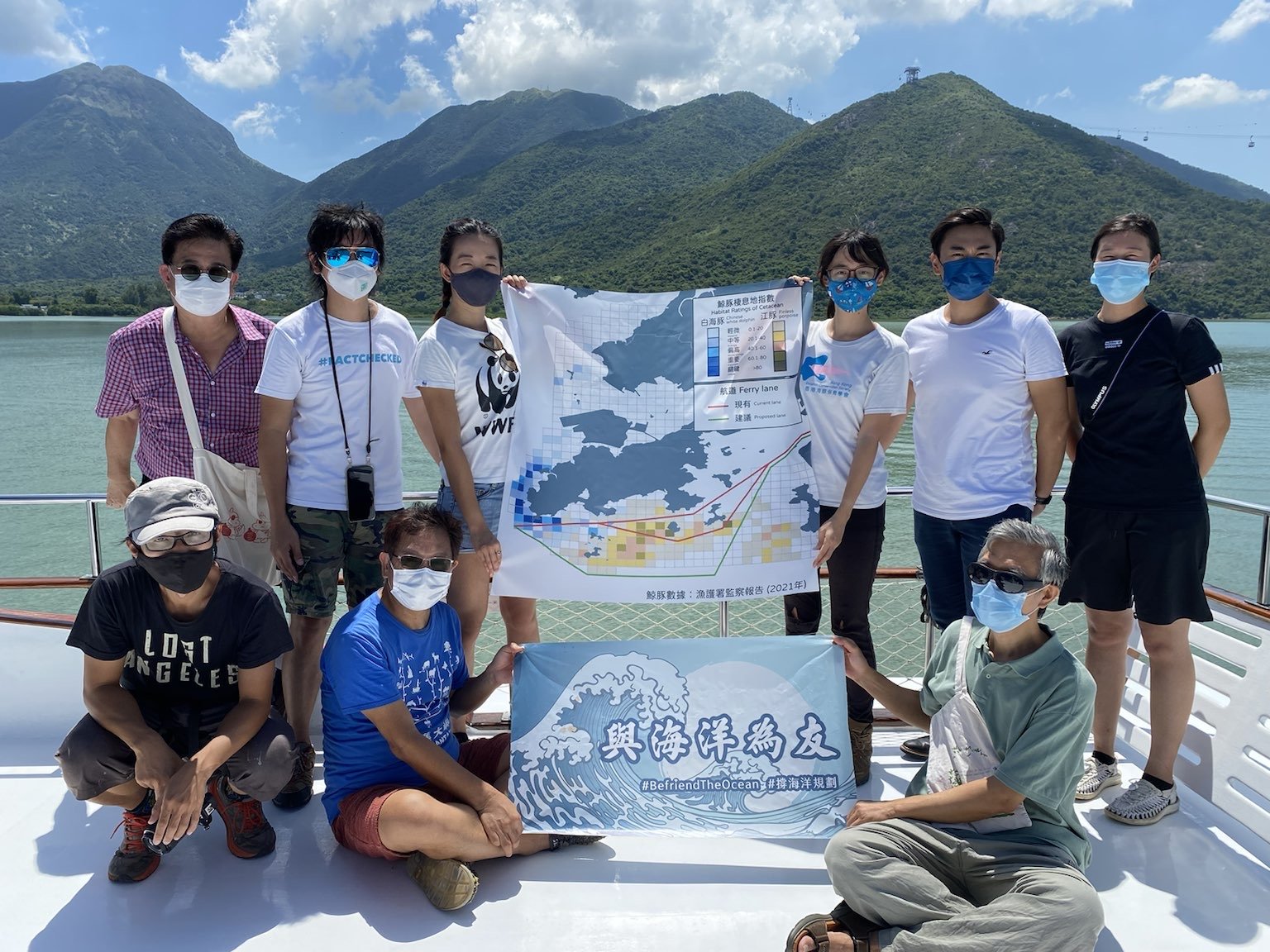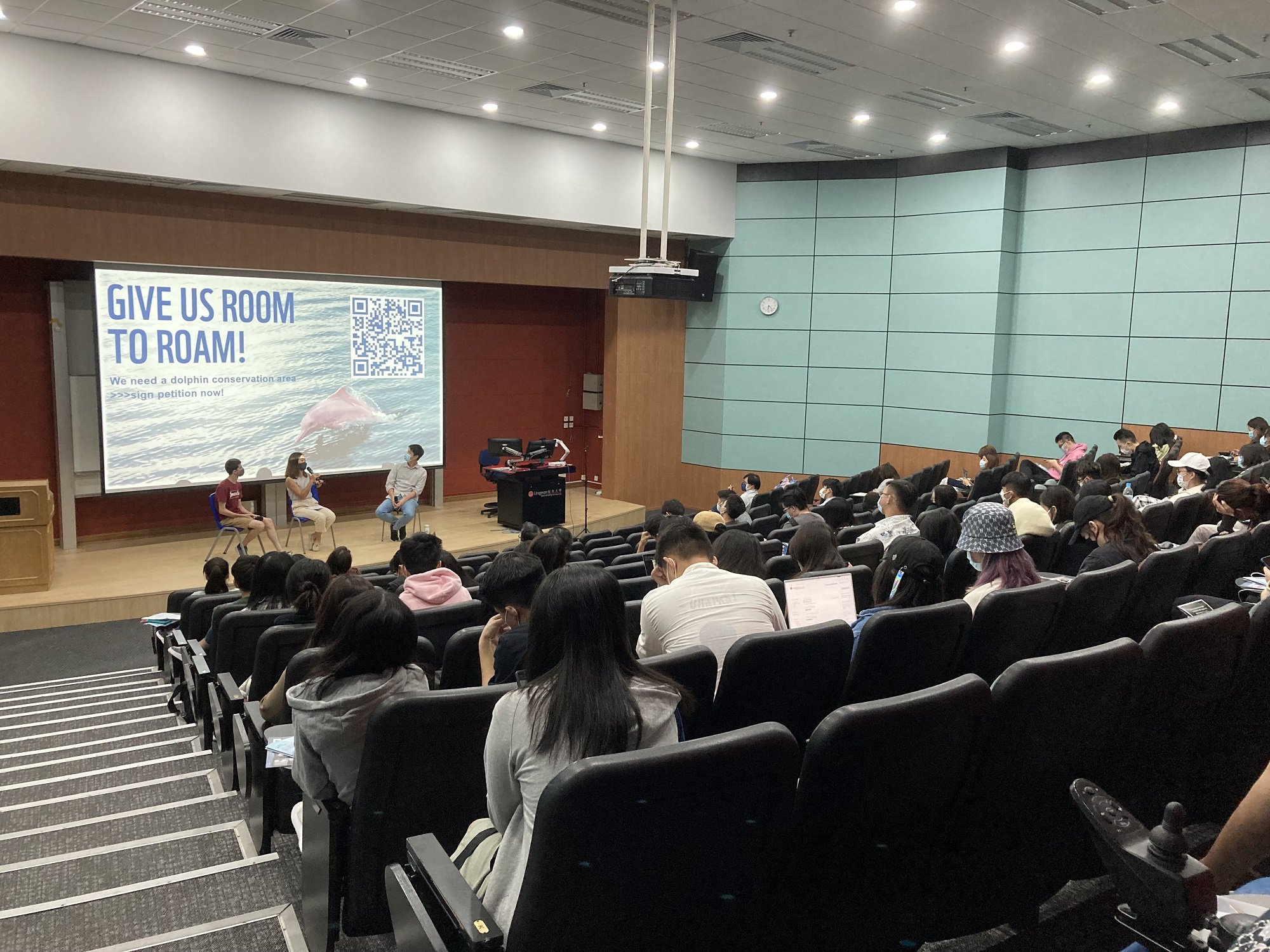Securing a future for the Chinese white dolphin
Working to safeguard the Chinese white dolphin © Eddie Tse, Save Lantau Alliance
Doris Woo remembers the first time she saw a Chinese white dolphin. It was 2016, and she was conducting a survey on a research vessel.
“It was quite exciting, as it was my first time seeing a marine mammal in Hong Kong, and the dolphin seemed interested in what we were doing. Unlike most other dolphin species which are grey, these have a distinctive pale pink hue, making them easy to spot. The experience strengthened my passion for marine mammal conservation.”
Doris Woo on a research vessel © Doris Woo / WWF
Since then, the numbers of Chinese white dolphins have continued to decline at an alarming rate. But Woo, now Project Manager for Cetacean Conservation at WWF-Hong Kong, remains undeterred in protecting the iconic species.
Disappearing habitat
Over the past few decades, the Pearl River Delta region – where China’s third-longest river flows into the South China Sea – has become one of the largest and fastest growing urban areas in the world, with a population of more than 70 million people.
The region is also home to a population of about 2,000 Chinese white dolphins (Sousa chinensis, also known as Indo-Pacific humpback dolphins) that swim along its shallow estuarine waters – where human activities are most intense.
A Chinese white dolphin (Sousa chinensis, also known as Indo-Pacific humpback dolphins). © Magnus Lundgren / www.wildwondersofchina.com / WWF
With rapid growth has come a rapid population decline of these iconic dolphins. Their numbers are falling by around three per cent every year; in Hong Kong – a critical area for the broader Pearl River Delta dolphin population – the number has dropped by more than 80 per cent in the past 17 years. The most recent government estimates indicate just 37 Chinese white dolphins are left in Hong Kong’s waters.
The biggest impact comes from coastal development projects, which are encroaching on their habitat. Like all humpback dolphins around the world, Chinese white dolphins need estuarine water to survive; water to the north lacks salinity, and water to the south is too salty. The construction of massive reclamation projects in their core habitats – including the third runway expansion of Hong Kong’s airport, the 55-km Hong Kong-Zhuhai-Macao Bridge and its boundary crossing facilities, and several reclamation projects along the coast of northern Lantau Island – have displaced the dolphins from critical breeding and feeding habitats, leaving them with nowhere else to go.
Woo explains these large-scale developments “also introduce other threats including underwater noise, intensified marine traffic which increases risk of boat strikes, and rising levels of toxins and pollutants from industrial runoff, which lowers the dolphins’ reproductive success and chance of survival.” Illegal and unsustainable fishing practices pose additional threats to the dolphins – depleting their prey and putting them at increased risk of entanglement in fishing gear.
With a dwindling population, a slow reproduction rate of three to five years, and a low survival rate of newborns, Chinese white dolphins are struggling to survive. Scientists predict local extinction of the species is imminent unless immediate action is taken.
Collaborative conservation action
To give Chinese white dolphins the best chance to stabilise and recover, WWF-Hong Kong, along with marine mammal experts, conservationists, and government representatives, published an Emergency Action Plan in 2020.
The plan identifies major threats to dolphins and their critical habitats, and advocates for a development-free Dolphin Conservation Management Area by 2024 that will protect important foraging and socialising habitats. It also proposes establishing a community-based working group to co-manage the Dolphin Conservation Management Area, and requires development projects to assess potential threats from construction, especially noise impacts, on Chinese white dolphins in the Environmental Impact Assessment process.
Map of key Chinese white dolphin habitats, from the Emergency Action Plan
Woo says the collaborative approach taken will be the key to its success: “Given Chinese white dolphins use both Hong Kong and Chinese waters, a cross-boundary plan is crucial for effective conservation. By engaging both the Hong Kong and Guangdong governments, we’ve provided a good framework for authorities to kick-start an urgent process and take the lead in activating timely and appropriate actions. We’re also working closely with WWF-China and lobbying our own government to implement the necessary conservation work.“
The plan will contribute to Hong Kong’s ongoing efforts to expand the marine protected area system (MPA) to cover 30 per cent of Hong Kong’s marine environment by 2030, through a network of science-based strict no-take reserves, fisheries management zones, community-based fishery reserves, and other MPA designations benefitting from well-enforced and science-based management.
Another key component of Woo’s work is raising awareness with residents of Hong Kong about Chinese white dolphins and the threats they face.
“We have conducted a survey to better understand the public’s willingness to pay for some of the costs to mitigate underwater noise and marine traffic impacts off South Lantau. Options include implementing a speed restriction zone, re-routing vessels away from critical dolphin habitats, and reducing the frequency of services.” Woo said. “So far we’ve received over 4,000 responses, and we will be announcing the survey results soon.”
A screening of the Sea of Noise documentary at Lingnan University © Doris Woo
She’s also helping to bring underwater noise pollution impacts to public attention through the screening of the Sea of Noise documentary, which has so far reached an audience of more than 5,200 in Hong Kong and has been streamed online nearly 520,000 times in broader China.
“We’ve been hosting sessions after the screenings that highlight how individuals can help – such as completing the survey, signing a petition to the government, and supporting responsible fishing methods through our Sustainable Seafood Guide.” This support is essential to foster the political and social change needed to turn things around for Chinese white dolphins. Woo says: “to secure a future for this iconic species, we cannot wait any longer, and we all have a role to play.”
Chinese white dolphins video, 2009 © WWF-Hong Kong (Note: i) dolphin numbers in 2019/20 have decreased >80% in 17 years, ii) the 2019/20 dolphin number estimate in Hong Kong is 37, as per the latest government monitoring).






